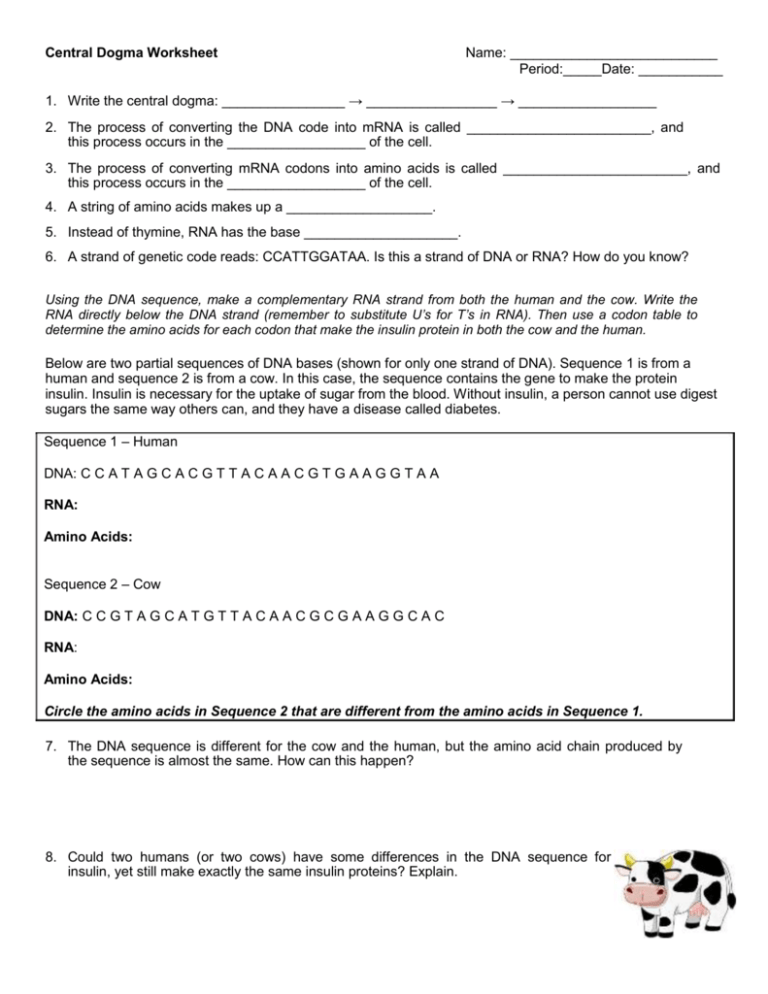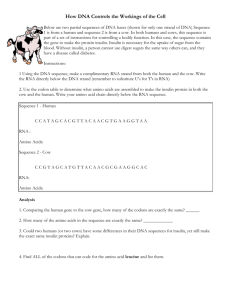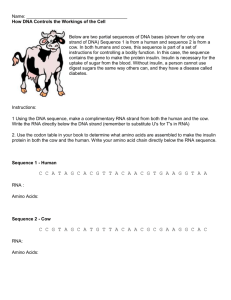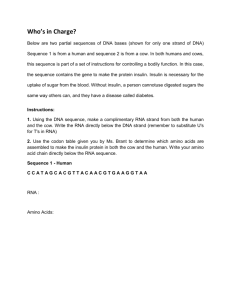Central Dogma Worksheet Name: Period:_____Date: ______ Write
advertisement

Central Dogma Worksheet Name: ___________________________ Period:_____Date: ___________ 1. Write the central dogma: ________________ → _________________ → __________________ 2. The process of converting the DNA code into mRNA is called ________________________, and this process occurs in the __________________ of the cell. 3. The process of converting mRNA codons into amino acids is called ________________________, and this process occurs in the __________________ of the cell. 4. A string of amino acids makes up a ___________________. 5. Instead of thymine, RNA has the base ____________________. 6. A strand of genetic code reads: CCATTGGATAA. Is this a strand of DNA or RNA? How do you know? Using the DNA sequence, make a complementary RNA strand from both the human and the cow. Write the RNA directly below the DNA strand (remember to substitute U’s for T’s in RNA). Then use a codon table to determine the amino acids for each codon that make the insulin protein in both the cow and the human. Below are two partial sequences of DNA bases (shown for only one strand of DNA). Sequence 1 is from a human and sequence 2 is from a cow. In this case, the sequence contains the gene to make the protein insulin. Insulin is necessary for the uptake of sugar from the blood. Without insulin, a person cannot use digest sugars the same way others can, and they have a disease called diabetes. Sequence 1 – Human DNA: C C A T A G C A C G T T A C A A C G T G A A G G T A A RNA: Amino Acids: Sequence 2 – Cow DNA: C C G T A G C A T G T T A C A A C G C G A A G G C A C RNA: Amino Acids: Circle the amino acids in Sequence 2 that are different from the amino acids in Sequence 1. 7. The DNA sequence is different for the cow and the human, but the amino acid chain produced by the sequence is almost the same. How can this happen? 8. Could two humans (or two cows) have some differences in the DNA sequence for insulin, yet still make exactly the same insulin proteins? Explain. MUTATIONS Diabetes is a disease characterized by the inability to break down sugars. Often a person with diabetes has a defective DNA sequence that codes for making the insulin protein. This mutation is called a point mutation because only one amino acid is affected. 9. a. Suppose a person has a mutation in their DNA, and the first triplet (three bases) for the insulin gene is CCC (instead of CCA). Determine what amino acid the new DNA triplet codes for. Will this person be diabetic? Remember to convert the DNA sequence into RNA before using the codon table to find the amino acid. b. What if the first triplet was CAA? 10. How is it that a code consisting of only four letters (A, T, G, C) can contain instructions for all the different parts of an organism and account for the diversity of organisms on this planet? A frameshift mutation occurs when a base is added or removed from a DNA or RNA sequence. 11. a. Determine the amino acid chain coded for by the following RNA sequence: A C C U C A G C U C C A b. Suppose a mutation occurs so that another A is added after the first codon (not the first base). What would the new sequence of amino acids be? DNA sequences are often used to determine relationships between organisms. DNA sequences that code for a particular gene can vary widely. Organisms that are closely related will have sequences that are similar. Below is a list of sequences for a few organisms: Human: CCA TAG CAC CTA Chimpanzee: CCA TAA CAC CTA Pig: CCA TGG AAA CGA Cricket: CCT AAA GGG ACG 12. Based on the sequences, which organism is most closely related to humans? 13. A fossil from an unknown organism is found in the forest. Its genome is sequenced and one gene is found to be C C A T G G A A T C G A. Based on the sequences in the table above, what kind of animal do you think this is?








